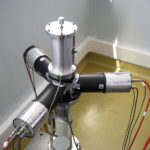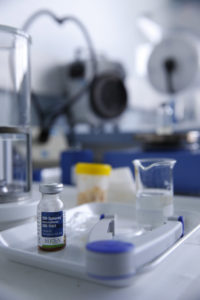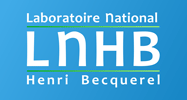Coincidence counting

Overview
Widely used in the field of radioactivity metrology, the 4πβ-γ coincidence method (Campion, 1959) is a direct method developed for measuring the activity of radionuclides whose decay is accompanied by at least two distinct types of ionizing radiation. Its use is not limited to the measurement of β-γ emitter activity, it also applies to radionuclides whose α or by electronic capture decay is followed by the emission of γ photons. In addition, the instrumentation can be adapted to γ-γ coincidence measurement for radionuclides such as 125I.
The principle of the 4πβ-γ coincidence method (Bobin, 2007) can be described in a simple way in the ideal case of a radionuclide decaying by β- emission followed by the simultaneous emission of a γ photon. The detection device and counting electronics consist of two separate and independent channels (known as β and γ), each of which is exclusively sensitive to a single type of radiation. The peculiarity of the coincidence method applied with classical instrumentation lies in the addition of an extra channel (called coincidence channel) whose counting is incremented each time a decay is detected simultaneously in the two channels β and γ.
The activity of a radioactive source is determined by calculating the ratio between the product of the individual channel count rates (β and γ) and the coincidence count rate. The particularity of the method is that this calculation does not require knowledge of the detection efficiency of the detectors used. In the real case of an excess counting in the β channel due to γ radiation of the source, the extrapolation technique is applied by variation of the detection efficiency in the β channel.
Instrumentation at the LNHB
At LNHB, the instrumentation dedicated to the coincidence method is composed of specific electronic modules developed in the laboratory, operating on the principle of extendable dead times and on the measurement of active time. Thus, when coincidences are counted using a resolution time, an instrumental correction of coincidences is possible without applying classical Cox and Isham formulas (Bouchard and Vatin, 1977; Chauvenet et al., 1986). In addition, the evolution of these electronic modules with the aim of applying the anticoincidence technique (Bouchard, 2000; 2002) makes it possible to count coincidences indirectly without the use of a resolution time. This technique is particularly interesting for the measurement of radionuclides with metastable states of a few ms such as 67Ga (Bobin et al., 2007).
The LNHB has several installations allowing to combine a proportional or liquid scintillation counter in β channel with a scintillator or semiconductor detector in γ channel. The liquid scintillation counter has the particularity of being equipped with three photomultipliers which also allow the application of the TDCR method (Triple to Double Coincidence Ratio).
Areas of application
Depending on the type of sources used, the measured activity can range from a few tens of Bq to several hundreds of kBq. The standard uncertainty is in the order of 0.1% for radionuclides such as 60Co.
Non-exhaustive list of radionuclides measured at LNHB by the coincidence method: 22Na, 24Na, 51Cr, 54Mn, 57Co, 59Fe, 60Co, 65Zn, 67Ga, 75Se, 85Sr, 88Y, 131I, 177Lu, 201Tl, 241Am, etc. It should be noted that the tracer technique makes it possible to extend the coincidence method to the measurement of the activity of pure β emitting radionuclides such as 14C (commonly used tracer: 60Co).
 Since 2009, the liquid scintillation meter has also been used for activity measurements directly in aqueous environment by Cherenkov effect (i. e. without mixing with a liquid scintillator). These Cherenkov effect measurements were applied to the 4πβ-γ and TDCR coincidence methods for the measurement of radiopharmaceutical activity such as 90Y (Bobin et al., 2010) and 11C (Thiam et al., 2010). Recently within the framework of the European MetroMRT project (2012-2015), a national reference has been established for the 90Y SIR-Spheres (Lourenço et al., 2015) resin microspheres produced by Sirtex (Australia) for the treatment of liver cancer by radioembolization. To this end, a new light emission model based on the Geant4 simulation code has been developed to take into account the different characteristics of Cherenkov photon emission in the three-photomultiplier counter (Bobin et al., 2010). This stochastic model has been extended to liquid scintillation activity measurements for the TDCR method (Bobin et al., 2012) and the extrapolation technique (Bobin et al., 2016).
Since 2009, the liquid scintillation meter has also been used for activity measurements directly in aqueous environment by Cherenkov effect (i. e. without mixing with a liquid scintillator). These Cherenkov effect measurements were applied to the 4πβ-γ and TDCR coincidence methods for the measurement of radiopharmaceutical activity such as 90Y (Bobin et al., 2010) and 11C (Thiam et al., 2010). Recently within the framework of the European MetroMRT project (2012-2015), a national reference has been established for the 90Y SIR-Spheres (Lourenço et al., 2015) resin microspheres produced by Sirtex (Australia) for the treatment of liver cancer by radioembolization. To this end, a new light emission model based on the Geant4 simulation code has been developed to take into account the different characteristics of Cherenkov photon emission in the three-photomultiplier counter (Bobin et al., 2010). This stochastic model has been extended to liquid scintillation activity measurements for the TDCR method (Bobin et al., 2012) and the extrapolation technique (Bobin et al., 2016).
REFERENCES:
– Bobin, C., 2007. Primary standardization of activity using the coincidence method based on analogue instrumentation. Metrologia 44, S27-S31.
– Bobin, C., Bouchard, J., Hamon, C., Iroulart, M.G., Plagnard, J., 2007. Standardization of 67Ga using a 4π(LS)β-γ anti-coincidence system. Appl. Radiat. Isot. 65, 757-763.
– Bobin, C., Thiam, C., Bouchard, J., Jaubert, F., 2010. Application of a stochastic TDCR model based on Geant4 for Cherenkov primary measurements. Appl. Radiat. Isot. 68, 2366–2371.
– Bobin, C., Thiam, C., Chauvenet, B., Bouchard, J., 2012. On the stochastic dependence between photomultipliers. Appl. Radiat. Isot. 70, 770-780.
– Bobin, C., Thiam, C., Bouchard., J., 2016. Calculation of extrapolation curves in the 4π(LS)β-γ coincidence technique with the Monte Carlo code Geant4. Appl. Radiat. 109, 319-324.
– Bouchard, J., Vatin, R., 1977. Développement de la technique des coïncidences. Bulletin BNM 30-8
– Bouchard, J., 2000. MTR2: a discriminator and dead-time module used in counting systems. Appl. Radiat. Isot. 52, 441-446.
– Bouchard, J., 2002. A new set of electronic modules (NIM standard) for a coincidence system using the pulse mixing method. Appl. Radiat. Isot. 56, 269-273.
– Campion, P.J., 1959. The standardization of radioisotopes by the beta-gamma coincidence method using high efficiency detectors. Int. J. Appl. Radiat. Isot. 4, 232-248.
– Chauvenet, B., Bouchard, J., Vatin, R., 1986 Properties of a 4πβ-γ coincidence system with a cumulative dead-time circuit Nucl. Instrum. Methods A 243 539-48
– Lourenço, V., Bobin, C., Chisté, V., Lacour, D., Rigoulay, R., Tapner, M., Thiam, C., Ferrreux, L., 2015. Primary standardization of SIR-Spheres based on the dissolution of the 90Y-labeled resin microspheres. Appl. Radiat. Isot. 97, 170-176.
– Thiam, C., Bobin, C., Bouchard, J., 2010. Radiopharmaceutical 11C activity measurements by means of the TDCR-Cherenkov method based on a Geant4 stochastic modeling, Proceedings of the 2010 International Liquid Scintillation Conference (LSC2010), 6–10 sept. 2010, 341-348.
Our job: metrology
dosimetry
Implemented methods for the establishment of national references must be adapted to the radiation type and its intensity. They are based on measurement technics such as calorimetry, ionometry and chemical dosimetry.
Radioactivity
The variety of the emitted radiation and physical forms of the sources oblige to adapt the measurement process in order to establish national references: methods with defined geometries, or 4 π countings geometries, coincidence countings, etc.
